Only The Creepiest Photos From Philippine History
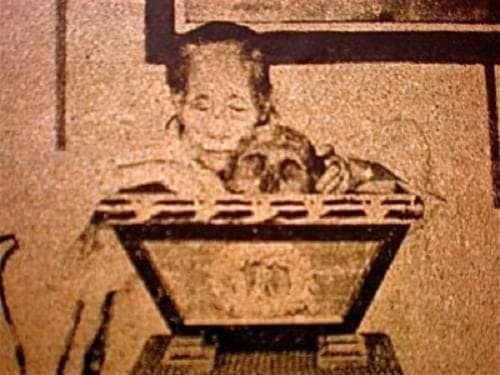
There’s more to Philippine history than boring facts and useless details. In fact, it is full of twists, mysteries, and everything nice–just like our typical evening telenovelas.
El Renacimiento Filipino, for example, was brimming with some of the most morbid pictures imaginable. From unusual deformities to recuerdos de patay (cadaver photos), this pre-war magazine is a must-have for every curious Filipino.
Here are just some candid shots showing the dark, macabre side of Philippine history:
“Gone Too Soon”
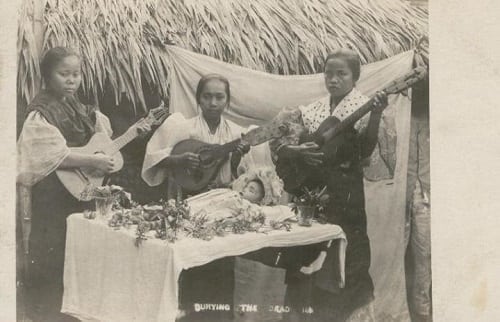
Our ancestors put so much importance to the departed. During the Victorian era, for instance, Americans consider postmortem photographs as an important part of their culture. They even put these images in their lockets or distribute them to friends and relatives.
Soon, Filipinos followed suit. In fact, grieving families usually hired photographers or painters to capture their loved one’s final moments. Teodora Alonzo, Paciano Rizal, and Mariano Ponce each had their own recuerdos de patay. The dead child photo above may not be as popular but still succeeds in reminding us of our own mortality.
“The Human Octopus”
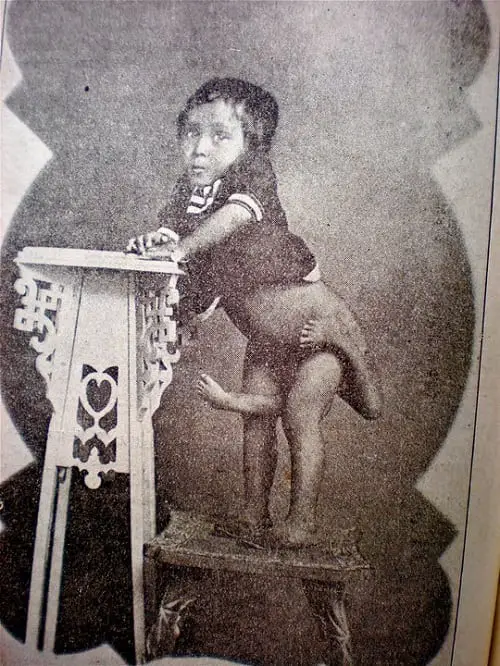
This fascinating photo is another gem from the defunct magazine El Renacimiento Filipino. It shows a child with a rare medical condition called Craniopagus parasiticus. This happens when conjoined twins fail to separate in the uterus. As a result, one of the twins die and reabsorbed, leaving only a few body parts intact at the time of delivery.
Also known as “parasitic twin”, this is the same condition that has affected Rudy Santos, a former circus performer. Now in his early 60’s, Rudy is the oldest person in history to ever live with such deformity.
“Farewell, Emilio Jacinto”
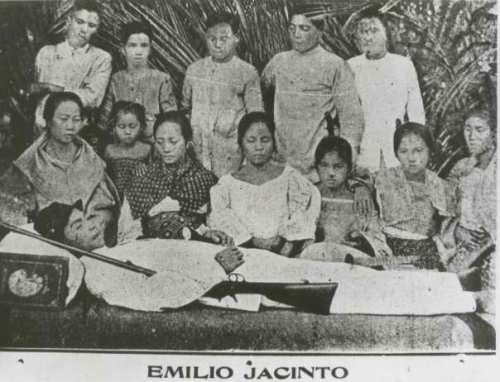
Perhaps you have already seen portraits of Emilio Jacinto plastered in postcards and notebooks before. Surprisingly, his first and only existing photo was actually his last one.
Also known as the “Brains of the Katipunan,” Emilio Jacinto died of malaria at the tender age of 23. At that time, people in Nueva Ecija was also accustomed to the ritual of taking postmortem photographs.
Also Read: 5 Young Pinoy Heroes Who Did Amazing Things Nobody Talks About
Shown in the picture above is the stiff remains of Emilio Jacinto in front of his grieving friends and family. Catalina de Jesus, the woman sitting on the second row (second from left), was Jacinto’s widow. It is believed that both married under Katipunan rites. Catalina, who hailed from Pampanga, was also pregnant at the time of Jacinto’s death.
“Water Cure”
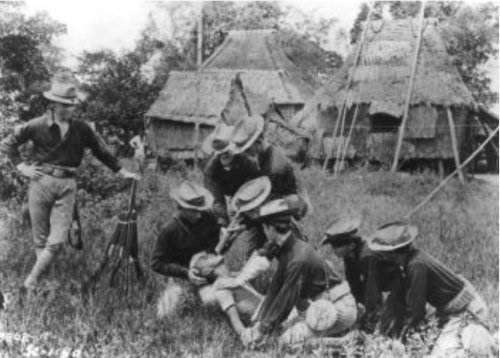
“Water cure” was a rampant torture method during the Philippine-American War. President Roosevelt even bragged that “nobody was seriously damaged” when American soldiers used it against Filipino insurgents. Or so he thought.
Truth be told, “water cure” is an inhumane and potentially fatal method of punishment. It was done by forcing a large bamboo stick to a person’s mouth. Gallons of water would then be poured down his throat, causing the stomach to bloat. If the person still refuses to answer, somebody would forcibly push the water out of his mouth. Only half of the torture victims managed to survive.
Also Read: 8 Dark Chapters of Filipino-American History We Rarely Talk About
“The Corpse of Casa Gorordo”
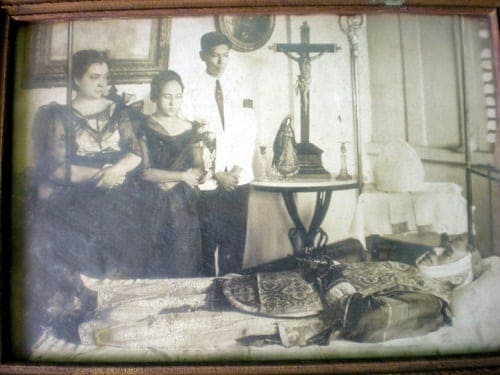
The Gorordos, who owns Casa Gorordo Museum, were among Cebu’s most influential families during the Spanish era. In fact, Bishop Juan Bautista Perfecto Gorordo (the corpse shown above) served as Cebu’s first Filipino bishop. He died in 1934 and was laid to rest using the traditional practices of that era.
And in case you’re wondering, the cloth encircling Bishop Gorordo’s head was purely for sanitary purposes. It stopped insects from entering his mouth and also prevented possible bacterial transmission.
“Hanging at Caloocan”
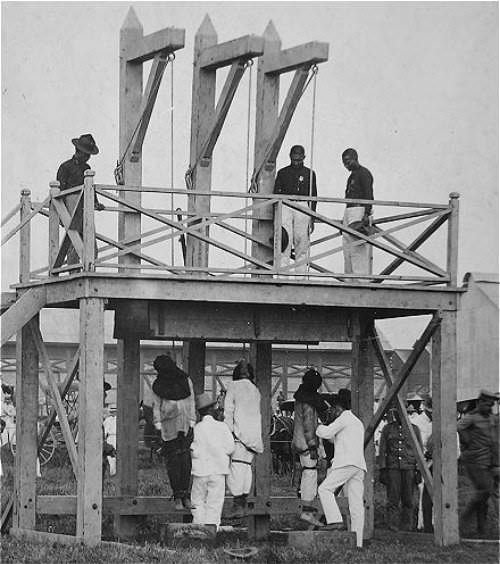
philippineamericanwar.webs.com)
Seeing an actual execution can be a spine-chilling experience you’ll never forget. So just imagine how the scene above would make you feel if you witnessed it firsthand.
The photo (circa 1900) is just one of the gruesome moments perpetrated by the Philippine-American War. The conflict between American soldiers and Filipino insurgents lasted from 1899 to 1902. It all started when a Filipino guerrilla was shot by an American patrol on February 4, 1899. Soon, Aguinaldo’s plan to build an independent nation backfired, resulting in a three-year conflict that brought thousands of fatality.
“Giant Snake”
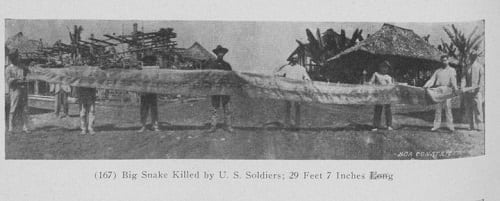
Who says the Philippines is only home to humongous crocodiles? Measuring 29 feet and 7 inches long, the big snake above was captured in the Philippine islands during the early 1900s.
The caption describes the animal as a “boa constrictor” which was obviously skinned and all its meat already removed. However, boa constrictors are more common in South America where it can grow up to 13 feet. It could be a species of reticulated phyton, considered endemic to Southeast Asia and one of the world’s longest reptiles. They are nonvenomous constrictors, meaning they don’t swallow their prey and only squeeze humans to death if feel threatened.
Featured image shows Teodora Alonso showcasing Jose Rizal’s skeletal remains at their house in Binondo. (Source: Prof. Ambeth Ocampo)
Also Read: 20 Haunting Last Pictures Taken in Philippine History
Reference
Ocampo, A. 1990. Looking back. Pasig, Metro Manila: Published and exclusively distributed Anvil Pub..
Written by FilipiKnow
FilipiKnow
FilipiKnow strives to ensure each article published on this website is as accurate and reliable as possible. We invite you, our reader, to take part in our mission to provide free, high-quality information for every Juan. If you think this article needs improvement, or if you have suggestions on how we can better achieve our goals, let us know by sending a message to admin at filipiknow dot net
Copyright Notice
All materials contained on this site are protected by the Republic of the Philippines copyright law and may not be reproduced, distributed, transmitted, displayed, published, or broadcast without the prior written permission of filipiknow.net or in the case of third party materials, the owner of that content. You may not alter or remove any trademark, copyright, or other notice from copies of the content. Be warned that we have already reported and helped terminate several websites and YouTube channels for blatantly stealing our content. If you wish to use filipiknow.net content for commercial purposes, such as for content syndication, etc., please contact us at legal(at)filipiknow(dot)net